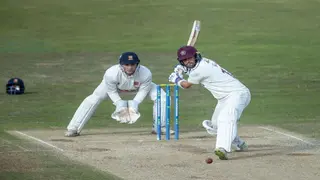Ranking the top 10 players with the most blocks in an NBA game
NBA
The 4-3-3 formation is, without a doubt, the most famous football formation in recent years. It is also among the select few equally successful at the youth and professional levels. Even with the advantages and disadvantages of every soccer system, many coaches, regardless of playing experience or skill level, favour the soccer number positions 4-3-3.

Many of Europe's best clubs have recently adopted the soccer 4-3-3 positions as their playing style. The formation, however, has proven to have an aggressive mindset from the beginning. It can overwhelm, disorient, and drive the opposition back toward their goal through effective midfield management and utilisation of the forwards' line-up's flexibility. Here is the famous 4-3-3 soccer formation explained.
The 4-3-3 soccer numbers employ four defenders (two centre-backs and two full-backs) behind a three-person midfield line.
The most common midfield layout consists of two players somewhat farther forward to either side and one guy deeper, referred to as the single pivot. The front line is then composed of a single centre-forward and two wide attackers who play on each side of him.
Ranking the top 10 players with the most blocks in an NBA game
NBA
Following a home loss to Uruguay in the 1950 World Cup final, Brazil adopted a 4-2-4 formation with a four-person backline. They continued to use this combination and went on to win the 1958 World Cup.
Brazil had switched to a 4-3-3 configuration by 1962, and Mário Zagallo had moved from attack to midfield. More dependable defensive midfielder Nobby Stiles was used in a 4-1-2-3 formation by the 1966 World Cup hosts and eventual victors, England.
The 4-3-3 soccer formation position was later adopted in Uruguay, Argentina, and Italy for many years. However, Rinus Michels' Ajax and Netherlands teams from the 1970s are arguably the most well-known for having served as models for adopting the shape.

When attacking full-backs, the wingers' key tasks include cutting inside to combine or moving around the outside of their opponents to cross in one-on-one situations. Inside strikers or wingers taken off surprise often use the latter strategy, expecting to cut inside and score.
How much does a cricket player make? Pro-player salary, average wage, coaches' salary
Cricket
When wingers keep a wide position, an offensive midfielder may have space to run into in the infield. Meanwhile, a full-back can overlap into the space provided outside by an infield winger.
As the onslaught intensifies, the lone centre-forward travels across the pitch to pin the opponent's ball-side centre-back. The forward can make straight runs past the opponent or drop short of linking and assisting in creating overloads in the central midfield.
These runs are frequently made to catch through passes and force the other team's defence back into more territory. This will free up space in the middle for wide forwards or midfielders to move into.
The trio in the middle of the field offers passing options for both attacking and building play. Two more offensively-minded midfielders frequently play in the inner channels and make forward runs between the centre-forward and winger.
During the build-up, the defence, particularly the centre-backs, concentrates on getting to the central midfield unit, mainly if there is a glut. The centre-backs frequently realign themselves to allow the deepest midfielder to drop into the back line during the build-up.
What is the biggest defeat in World Cup history? Embarrassing World Cup facts
Football
A 4-3-3 position is an effective way to press high up the field when three players are in the attacking end. With the centre-forward trying to stop any play change, the wingers can narrow to block the central areas before pressing outwards to force the ball wide.

If needed, the three centre midfielders may quickly switch between being one advanced midfielder and two defensive midfielders. They also cover and defend core areas. This can happen while pressing or when a block forms.
With the midfield three providing cover, the back four will stay compact when defending in a set block as long as possible.
Manchester City under Pep Guardiola and Liverpool under Jurgen Klopp are two excellent examples of two teams that use the 4-3-3 formation in quite different ways. To help his team control possession in midfield, Pep frequently deployed full-backs inverted.
All-time best: Top 15 left-backs in the world in 2023 ranked
Football
In an attempt to create as large of a field as possible, his wingers remain high and wide. He will play in centre midfield alongside two attacking number 10s who will combine to form an attacking front five by attacking alongside the strikers and wingers.
In contrast, Liverpool's two full-backs were critical in providing breadth and ingenuity in attacking situations. Their wingers typically operate between the opposition's central defender and full-back, putting them closer to the number nine player.
Their three-person midfield applies pressure on the ball anywhere on the field as a cohesive, intelligent, pressing unit.
The 4-3-3 soccer numbers form natural triangles, which frequently provide the person in possession with multiple passing possibilities at any one time. Compared to some other formations, this makes developing a possession-based style of play easier.
To further aid in controlling possession, the three-player midfield unit can produce overloads in critical zones.
Top 15 best power forwards of all time ranked: Who tops the list?
NBA

Many players can move forward and attack with ease because of the structure. Many 4-3-3 teams will finish with a five-person front line, with the full-backs or attacking midfielders lining up with the centre-forward and wingers.
Another effective configuration to press from is the soccer positions by number 4-3-3. Three forwards give you plenty of numbers to pressure the other team's defence.
In a soccer player position number 4-3-3, the space left between the winger and full-back is open for the opponent to target and exploit. Usually, rapid counterattacks and quick, straight-play swaps are used to achieve this.
Teams need more men to effectively slow down or halt opposition counterattacks when using this configuration, which encourages players to charge forward and join the attack.
Lack of assistance from wide attackers or advanced midfielders can leave a lone centre-forward isolated in attack, leaving them underloaded against opposing centre-backs.
Who are the 10 best Eagles players of all-time? A ranked list
NFL
The famous formation's weakness includes giving teammates less time to make supporting runs and thus could imply an adequate offensive presence in the penalty area. Here are some of the frequently asked questions about the 4-3-3 soccer numbers.
Rapid ball movement, tight defensive marking, and quick attacking transitions are all essential for the 4-3-3 formation to be successful.
In this formation, teams should focus on maintaining possession of the ball and using the field's width to create scoring opportunities.
They are used to help release pressure. While the deeper midfielders create space behind the ball, one attacking midfielder will make late runs into the box on wide passes.

While certain formations, like 4–5–1, are renowned for being extremely defensive, others, like 3–4–3, are recognized for being aggressive, not many have the balance of both. Here's where the 4-3-3 shines.
A comprehensive guide to soccer formations for tactical excellence: Which is the best formation?
Football
The ideal configuration for players looking to counterattack well is 5-3-2.
While there have been many effective formations throughout the history of modern football, the 4-3-3 configuration sticks out. Four defenders, three midfielders, and three strikers make up this configuration.
Players, coaches, and supporters must comprehend the soccer number positions 4-3-3. In contemporary football, it is a commonly utilised and favoured configuration. In terms of attacking and defending, the formation's four defenders, three midfielders, and three strikers offer a balanced approach. The formation's adaptability permits tactical changes and adjustments throughout the match.
READ MORE: 10 oldest sports in the world: when were they invented?
Sports Brief has compiled a list of the ten oldest sports in the world, detailing when they were invented. Some archaeological evidence indicated that some sports have existed for over 15,300 years and were meant precisely for enjoyment.
Different types of sports have different ways and rules concerning how they are played. Over the years, athletes have transformed it into a full-time profession and, without a doubt, one of the highest-paying careers in the world.